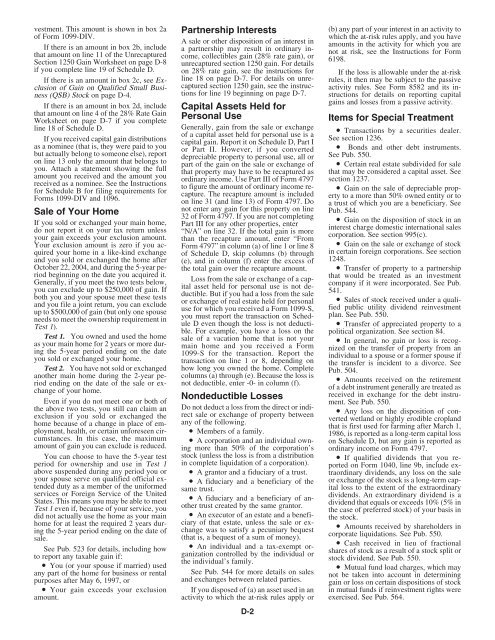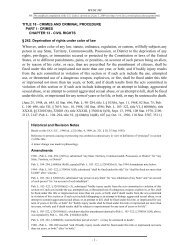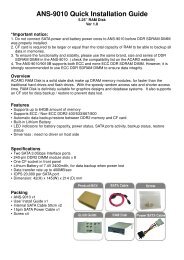2004 Instructions for Form 1040 (ALL) - Supreme Law Firm
2004 Instructions for Form 1040 (ALL) - Supreme Law Firm
2004 Instructions for Form 1040 (ALL) - Supreme Law Firm
You also want an ePaper? Increase the reach of your titles
YUMPU automatically turns print PDFs into web optimized ePapers that Google loves.
Partnership Interests<br />
vestment. This amount is shown in box 2a<br />
(b) any part of your interest in an activity to<br />
of <strong>Form</strong> 1099-DIV.<br />
which the at-risk rules apply, and you have<br />
A sale or other disposition of an interest in<br />
If there is an amount in box 2b, include<br />
amounts in the activity <strong>for</strong> which you are<br />
a partnership may result in ordinary inthat<br />
amount on line 11 of the Unrecaptured not at risk, see the <strong>Instructions</strong> <strong>for</strong> <strong>Form</strong><br />
come, collectibles gain (28% rate gain), or<br />
Section 1250 Gain Worksheet on page D-8<br />
6198.<br />
unrecaptured section 1250 gain. For details<br />
if you complete line 19 of Schedule D. on 28% rate gain, see the instructions <strong>for</strong> If the loss is allowable under the at-risk<br />
If there is an amount in box 2c, see Excaptured<br />
section 1250 gain, see the instruc- activity rules. See <strong>Form</strong> 8582 and its in-<br />
line 18 on page D-7. For details on unre- rules, it then may be subject to the passive<br />
clusion of Gain on Qualified Small Busitions<br />
<strong>for</strong> line 19 beginning on page D-7. structions <strong>for</strong> details on reporting capital<br />
ness (QSB) Stock on page D-4.<br />
gains and losses from a passive activity.<br />
If there is an amount in box 2d, include<br />
Capital Assets Held <strong>for</strong><br />
that amount on line 4 of the 28% Rate Gain<br />
Personal Use Items <strong>for</strong> Special Treatment<br />
Worksheet on page D-7 if you complete<br />
line 18 of Schedule D.<br />
Generally, gain from the sale or exchange • Transactions by a securities dealer.<br />
of a capital asset held <strong>for</strong> personal use is a<br />
If you received capital gain distributions<br />
See section 1236.<br />
capital gain. Report it on Schedule D, Part I<br />
as a nominee (that is, they were paid to you<br />
or Part II. However, if you converted • Bonds and other debt instruments.<br />
but actually belong to someone else), report depreciable property to personal use, all or See Pub. 550.<br />
on line 13 only the amount that belongs to<br />
part of the gain on the sale or exchange of • Certain real estate subdivided <strong>for</strong> sale<br />
you. Attach a statement showing the full<br />
that property may have to be recaptured as that may be considered a capital asset. See<br />
amount you received and the amount you<br />
ordinary income. Use Part III of <strong>Form</strong> 4797 section 1237.<br />
received as a nominee. See the <strong>Instructions</strong> to figure the amount of ordinary income re<strong>for</strong><br />
Schedule B <strong>for</strong> filing requirements <strong>for</strong> • Gain on the sale of depreciable prop-<br />
capture. The recapture amount is included<br />
<strong>Form</strong>s 1099-DIV and 1096. erty to a more than 50% owned entity or to<br />
on line 31 (and line 13) of <strong>Form</strong> 4797. Do a trust of which you are a beneficiary. See<br />
not enter any gain <strong>for</strong> this property on line Pub. 544.<br />
Sale of Your Home<br />
32 of <strong>Form</strong> 4797. If you are not completing<br />
If you sold or exchanged your main home,<br />
• Gain on the disposition of stock in an<br />
Part III <strong>for</strong> any other properties, enter<br />
do not report it on your tax return unless<br />
interest charge domestic international sales<br />
“N/A” on line 32. If the total gain is more<br />
your gain exceeds your exclusion amount.<br />
corporation. See section 995(c).<br />
than the recapture amount, enter “From<br />
Your exclusion amount is zero if you ac- <strong>Form</strong> 4797” in column (a) of line 1 or line 8 • Gain on the sale or exchange of stock<br />
quired your home in a like-kind exchange of Schedule D, skip columns (b) through in certain <strong>for</strong>eign corporations. See section<br />
and you sold or exchanged the home after (e), and in column (f) enter the excess of 1248.<br />
October 22, <strong>2004</strong>, and during the 5-year pe- the total gain over the recapture amount. • Transfer of property to a partnership<br />
riod beginning on the date you acquired it.<br />
Loss from the sale or exchange of a capthat<br />
would be treated as an investment<br />
Generally, if you meet the two tests below,<br />
ital asset held <strong>for</strong> personal use is not deyou<br />
can exclude up to $250,000 of gain. If<br />
company if it were incorporated. See Pub.<br />
ductible. But if you had a loss from the sale<br />
541.<br />
both you and your spouse meet these tests<br />
or exchange of real estate held <strong>for</strong> personal • Sales of stock received under a quali-<br />
and you file a joint return, you can exclude<br />
use <strong>for</strong> which you received a <strong>Form</strong> 1099-S, fied public utility dividend reinvestment<br />
up to $500,000 of gain (but only one spouse<br />
you must report the transaction on Schedneeds<br />
to meet the ownership requirement in<br />
plan. See Pub. 550.<br />
Test 1).<br />
ule D even though the loss is not deducti- • Transfer of appreciated property to a<br />
ble. For example, you have a loss on the political organization. See section 84.<br />
Test 1. You owned and used the home sale of a vacation home that is not your<br />
as your main home <strong>for</strong> 2 years or more dur- • In general, no gain or loss is recog-<br />
main home and you received a <strong>Form</strong><br />
ing the 5-year period ending on the date<br />
nized on the transfer of property from an<br />
1099-S <strong>for</strong> the transaction. Report the<br />
you sold or exchanged your home.<br />
individual to a spouse or a <strong>for</strong>mer spouse if<br />
transaction on line 1 or 8, depending on the transfer is incident to a divorce. See<br />
Test 2. You have not sold or exchanged how long you owned the home. Complete Pub. 504.<br />
another main home during the 2-year pe- columns (a) through (e). Because the loss is<br />
riod ending on the date of the sale or exof<br />
a debt instrument generally are treated as<br />
not deductible, enter -0- in column (f). • Amounts received on the retirement<br />
change of your home.<br />
Nondeductible Losses<br />
received in exchange <strong>for</strong> the debt instru-<br />
Even if you do not meet one or both of ment. See Pub. 550.<br />
the above two tests, you still can claim an Do not deduct a loss from the direct or indirect<br />
sale or exchange of property between • Any loss on the disposition of con-<br />
exclusion if you sold or exchanged the<br />
any of the following.<br />
verted wetland or highly erodible cropland<br />
home because of a change in place of em- that is first used <strong>for</strong> farming after March 1,<br />
ployment, health, or certain un<strong>for</strong>eseen cir- • Members of a family. 1986, is reported as a long-term capital loss<br />
cumstances. In this case, the maximum • A corporation and an individual own- on Schedule D, but any gain is reported as<br />
amount of gain you can exclude is reduced. ing more than 50% of the corporation’s ordinary income on <strong>Form</strong> 4797.<br />
You can choose to have the 5-year test stock (unless the loss is from a distribution • If qualified dividends that you rein<br />
complete liquidation of a corporation). ported on <strong>Form</strong> <strong>1040</strong>, line 9b, include ex-<br />
period <strong>for</strong> ownership and use in Test 1<br />
above suspended during any period you or • A grantor and a fiduciary of a trust. traordinary dividends, any loss on the sale<br />
your spouse serve on qualified official ex- • A fiduciary and a beneficiary of the or exchange of the stock is a long-term captended<br />
duty as a member of the uni<strong>for</strong>med same trust.<br />
ital loss to the extent of the extraordinary<br />
services or Foreign Service of the United<br />
• A fiduciary and a beneficiary of andividends.<br />
An extraordinary dividend is a<br />
States. This means you may be able to meet<br />
other trust created by the same grantor.<br />
dividend that equals or exceeds 10% (5% in<br />
Test 1 even if, because of your service, you<br />
the case of preferred stock) of your basis in<br />
did not actually use the home as your main • An executor of an estate and a benefi-<br />
the stock.<br />
home <strong>for</strong> at least the required 2 years dur- ciary of that estate, unless the sale or ex-<br />
change was to satisfy a pecuniary bequest • Amounts received by shareholders in<br />
ing the 5-year period ending on the date of<br />
(that is, a bequest of a sum of money).<br />
corporate liquidations. See Pub. 550.<br />
sale.<br />
• An individual and a tax-exempt or- • Cash received in lieu of fractional<br />
See Pub. 523 <strong>for</strong> details, including how<br />
ganization controlled by the individual or<br />
shares of stock as a result of a stock split or<br />
to report any taxable gain if:<br />
the individual’s family.<br />
stock dividend. See Pub. 550.<br />
• You (or your spouse if married) used<br />
• Mutual fund load charges, which may<br />
any part of the home <strong>for</strong> business or rental See Pub. 544 <strong>for</strong> more details on sales not be taken into account in determining<br />
purposes after May 6, 1997, or<br />
and exchanges between related parties. gain or loss on certain dispositions of stock<br />
• Your gain exceeds your exclusion If you disposed of (a) an asset used in an in mutual funds if reinvestment rights were<br />
amount.<br />
activity to which the at-risk rules apply or exercised. See Pub. 564.<br />
D-2













